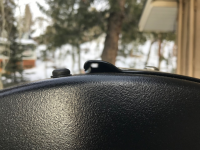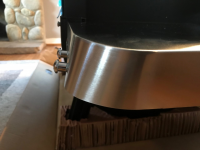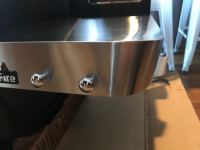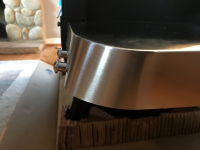You are using an out of date browser. It may not display this or other websites correctly.
You should upgrade or use an alternative browser.
You should upgrade or use an alternative browser.
My EX4
- Thread starter RStephen
- Start date
Running a second burn in on it. Ran it about an hour and a half and it still had a off-gas/VOC smell to it while running. So shut it down, let it cool off, and wiped it down really good inside before running it again. Takes it about 10 minutes to hit 600F and it is 25F outside. Got some spare ribs waiting on the counter, need to prep a side.
Quick question, coming from my Smokey Mountain, everything was about sealing up gaps and making it more efficient. Has anyone put a gasket along the top to seal the lid to the body when closed? Thinking if I put a strip down through here I could seal it up pretty well. Seems like a large opening along the full length to let heat out, especially with it being at the top.

Quick question, coming from my Smokey Mountain, everything was about sealing up gaps and making it more efficient. Has anyone put a gasket along the top to seal the lid to the body when closed? Thinking if I put a strip down through here I could seal it up pretty well. Seems like a large opening along the full length to let heat out, especially with it being at the top.

Jon Tofte
TVWBB 1-Star Olympian
I am no expert, but I am in agreement that the system is different. Weber is "training" their software to work optimally with how the SmokeFire is designed, so too much modifications may not actually be a good thing. Of course, a bent hood or some other part not fitting correctly is another story.
I am no expert, but I am in agreement that the system is different. Weber is "training" their software to work optimally with how the SmokeFire is designed, so too much modifications may not actually be a good thing. Of course, a bent hood or some other part not fitting correctly is another story.
I get this way of thinking, but if the system is being "trained to function optimally", then how is it possible for it to function in different environments? I may be totally wrong, but I would think The system is functioning based on the information the thermometer is sending it. If the unit is able to hold heat longer/better by being more air tight, then that unit has become more efficient and (again in my opinion only) would only seem to benefit the unit by not having to feed as much fuel, or operate the fan as often.
Tim
Lew Newby
R.I.P. 1/26/2024
There's a slot in the cooking chamber next the right hinge. Open the lid and look and you'll see it. That's for the probe wires. Also, don't add gaskets to it.Thanks for the points of view. I was assuming I was probably missing something by applying what I knew from a completely different system.
The vent hole on the back, closest to the controller, looked like a good route to me for the probes.
I do not believe that there is anything in the controller that is "optimal." It is simply what is the right response to stay at the given set point. It does not care how much air, pellets, etc. that is required to maintain that set point.I get this way of thinking, but if the system is being "trained to function optimally", then how is it possible for it to function in different environments? I may be totally wrong, but I would think The system is functioning based on the information the thermometer is sending it. If the unit is able to hold heat longer/better by being more air tight, then that unit has become more efficient and (again in my opinion only) would only seem to benefit the unit by not having to feed as much fuel, or operate the fan as often.
Tim
Pretty much, yes. It is a solution in search of a problem.If one were to add a gasket around inconsequential leaks wouldn't there still be the same volume of "leaks" but it would flow through the exhaust vents? If so, wouldn't that imply there is no point in sealing the unit?
So I've cooked ribs, bunch of chicken for weekly lunches, bone in prime rib, a ham, and a few other things. Mainly running between 275F and 375F. It has usually been around 30F-45F ambient temp during the cooks. I seem to be burning around 4 lbs. of pellets per hour. I had read that most people seem to be burning around 2 lbs. per hour. So I am back thinking about this again. Less leaks, less heat escaping, less fuel burnt. Saw on another site a guy seal the sides and bottom of his lid with Lava Lock.
Scott Quimby
TVWBB Fan
That's where I run them.Thanks for the points of view. I was assuming I was probably missing something by applying what I knew from a completely different system.
The vent hole on the back, closest to the controller, looked like a good route to me for the probes.



